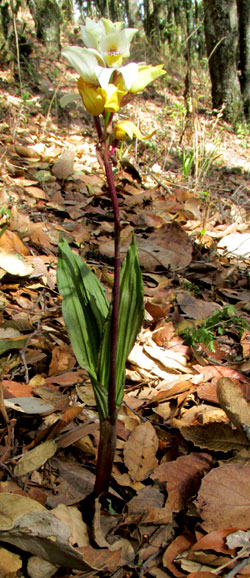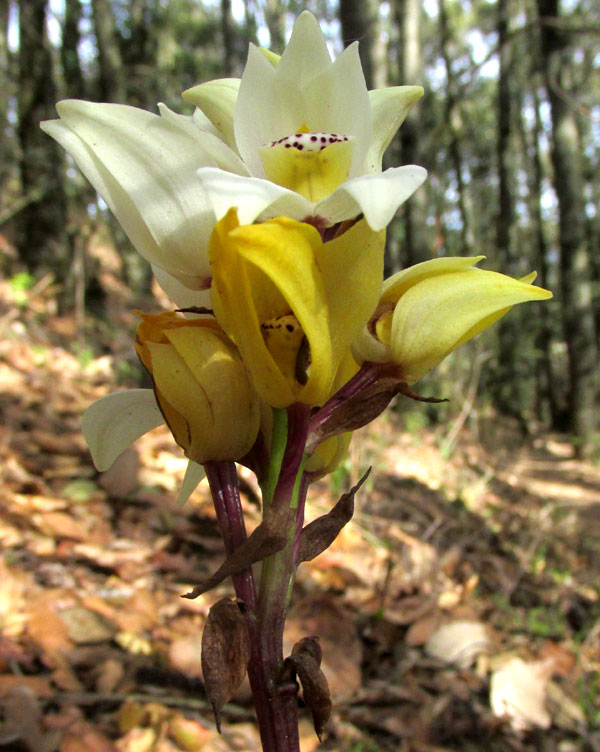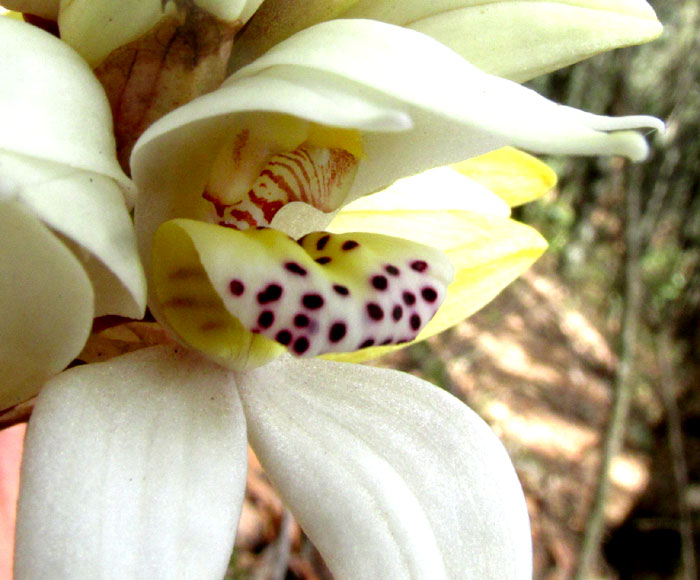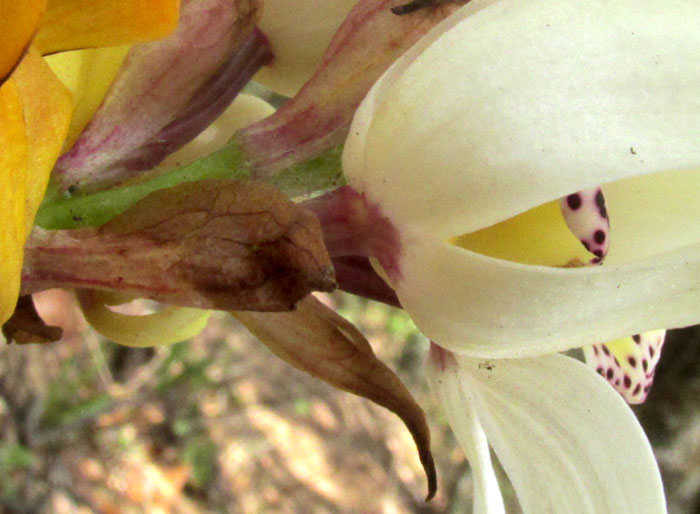Excerpts from Jim Conrad's
Naturalist Newsletter
entry from field notes dated July 29, 2022, taken in an oak forest atop Cerro de la Cruz, elevation ~2885m (~9465 ft), rising on the south side of the community of El Pinar, Amealco de Bonfil, Querétaro, MÉXICO, (~N20.17°, ~W100.17°)
GOVENIA CAPITATA
 Near the peak of Cerro de la Cruz the orchid at the right stood about a foot tall above a thick carpet of oak leaves mantling the eastern slope. Earlier and lower in elevation several of these plants had shown up at scattered locations, but not in flower. Here near the colder, more windswept summit, finding a blossoming individual was a surprise.
Near the peak of Cerro de la Cruz the orchid at the right stood about a foot tall above a thick carpet of oak leaves mantling the eastern slope. Earlier and lower in elevation several of these plants had shown up at scattered locations, but not in flower. Here near the colder, more windswept summit, finding a blossoming individual was a surprise.
Depending on who is counting, either the Composite/Aster Family or the Orchid Family are the most species-rich of all plant families. If you count probable undiscovered species, then the Orchid Family, with possibly 35,000 species in maybe 800 genera, may be the largest. That's because orchid species are mostly tropical, with many presumed undocumented species remaining in little-explored, fast-disappearing places. When you find an orchid in the tropics, be prepared for a challenging identification.
The above picture provides the first important field mark: The plant is terrestrial, not growing on a tree as an epiphyte. John Atwood's outdated (1986) "The size of the Orchidaceae and the Systematic Distribution of Epiphytic Orchids" estimates that epiphytic species account for 73% of the family's species. Our plant by simply emerging from the ground already disqualifies nearly ¾ of all potential orchid identities.
Below, the flowers show more important field marks.

In the Orchid family, the Orchidaceae, flowers can arrange themselves either along a stem, or at the stem's tip. They can occur in spikes, racemes, panicles or cymes. The above flowers are in terminal racemes, racemes being where each flower is attached to its own stalk, or pedicel, branching off the main stem. Lower flowers are yellow, indicating that they've been pollinated. Yellow flowers, being less bright than white ones, encourage pollinators to visit the white ones needing pollination, not themselves.

Above it's seen that the flower's lip, or labellum, is purple-spotted at its tip, yellowing at its base. Above the labellum, the curved, purple-striped item is the column, the most extraordinary feature of an orchid flower, for it's formed from the fusion of the male stamens the female pistil. Columns avoid self pollination with complex anatomy and reliance on certain behavior of animal pollinators. Here's the flower from the side:

Blossoms of many orchid species display "spurs" projecting behind them, where nectar is provided for pollinators, but this species doesn't.

Finally, the plant has unusually thick, rounded stems and the conspicuously pleated leaves gradually unwrap from around the stem, instead of opening like a folded sheet of paper. Also, on all observed plants there were just two leaves atop each, as opposed to a different number arising directly from the ground, or along the stem.
No flora dealing with the section of the Orchid family to which our species belongs, and covering this part of Mexico, is available. However, Robert Dressler's 2009 treatment of the section is {was?} online as a volume of the Flora Mesoamericana. It treats Central America and southern Mexico orchids, but not those of our area. Still, Dressler's work led me to the genus Govenia, which comprises about 30 species. Our plant wasn't featured in this work.
By doing an image search on the keywords "Govenia Mexico" one of many images turned up showing our plant, identified as GOVENIA CAPITATA with no Spanish or English name. According to some sources the species is endemic just to the higher uplands of Mexico, while other sources have it extending on south through most of highland Central America.
In another work by Robert Dressler, his 1972 "Notas sobre el género Govenia en México describes Govenia capitata as occupying oak-pine forests in which the soils abound with leafcover or humus, between the elevations of 2000-3000 meters. No pines occurred in our forest.
Orchid seeds are so tiny that when they germinate they need much more energy to grow than is stored in the seed. That energy is supplied by mycorrhiza, which must be present in the soil. Graduate student Susana Padrón Hernández, in her thesis "Germinación asimbiótica in vitro de Govenia capitata (Orchidaceae)," says that our orchid has a symbiotic relationship with the mycorrhizal fungus Rhizoctonia. Just when our plant's seeds need energy to sprout, Rhizoctonia is there -- if the soil is rich with plenty of humus and is unpolluted by fungus-killing chemicals -- providing that energy in the form of carbohydrates.